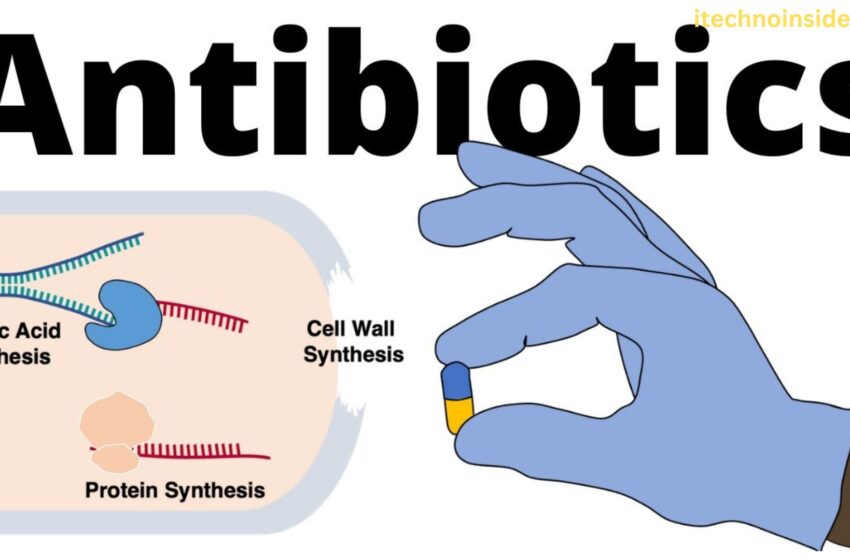
What Are Antibiotics?
Antibiotics are chemical substances that inhibit (stop) the growth of or kill microorganisms, especially bacteria. They came into widespread use about 70 years ago when penicillin was discovered. Some antibiotics are designed to target specific pathogenic bacteria while others, such as the quinolones and tetracyclines, act against many different kinds of bacteria. These broad-spectrum medicines can be helpful when it’s not possible or practical to perform sensitivity testing before starting treatment.
How They Work-Antibiotics
Antibiotics kill or inhibit the growth of bacteria. They do not affect viruses, fungi, or parasites, and they do not harm healthy cells.
There are many ways that antibiotics can kill bacteria, but most of them involve disrupting the bacterium’s cell structure or interfering with its chemical processes. For example, the antibiotic penicillin keeps a bacterium from building its cell wall; other types of antibiotics work by inhibiting different stages of bacterial cell wall production. Other antibiotics destroy bacteria by rupturing their cells or interfering with the ability of the bacteria to store and use energy. Still others interfere with the bacterium’s DNA-building or protein-copying machinery. Some antibiotics kill bacteria by displacing them from the area of the body where they normally live (aerobic); other antibiotics, such as vancomycin and fidaxomicin, target bacteria that cannot survive without oxygen (anaerobic).
If you take an antibiotic and do not finish the entire course prescribed by your doctor, low levels of the antibiotic may remain in your body. These lower levels may allow the bacteria to re-infect you or become resistant to the antibiotic. In addition, if you are taking antibiotics to treat a viral infection (such as the common cold or flu), the antibiotics will not help and in fact could make you feel worse. Using fewer and stronger antibiotics, as well as taking them only when they are needed, can help prevent the development of resistance.
What Causes Infections
Bacteria are tiny single-cell microorganisms that are everywhere in the environment. They can cause a wide range of illness, from mild to serious. Some bacterial infections may affect only the skin, throat or ears (for example, strep throat and ear infections), while others are more serious and can attack internal organs, such as the kidneys, lungs and brain (for example, pyelonephritis, meningitis and encephalitis).
Infections can be caused by both bacteria and viruses. It is important for your health care professional to determine what is causing your symptoms, so they can prescribe the correct medication. Health care professionals may use tests such as a blood test, urine sample or throat swab to identify the type of infection. The location and pattern of your symptoms can also help them to distinguish between bacteria and viruses.
Some bacterial infections can be contagious from person to person, such as whooping cough, tuberculosis and strep throat. Other bacterial infections are spread to people through contact with contaminated objects or surfaces, such as food, water and unpasteurized milk, or by mosquitoes, fleas and ticks (for example, gonorrhea and syphilis).
Infections may also be caused by other conditions, such as malnutrition or the presence of certain medical conditions or implants, such as a heart valve or artificial joint. Infections are also more common in some parts of the world because of limited access to vaccines and poor hygiene and sanitation practices.
The Types of Infections They Treat
There are different kinds of antibiotics, each one used to treat certain infections. For example, strep throat is treated with an antibiotic called penicillin. Acute bronchitis and inner ear infections are treated with an antibiotic called amoxicillin. Antibiotics also help prevent infections after surgery or other medical procedures. They are given in the form of liquid, tablets, or capsules taken by mouth, creams or sprays applied to the skin, eye ointments, and sometimes through an injection or intravenously (IV).
Bacteria can cause many different kinds of infection. Some are very serious, such as septicaemia, a deadly blood infection. Others are less serious, such as a sore throat or a minor cut. Doctors evaluate which bacteria are causing an infection, then choose the antibiotic that is most likely to be effective against those bacteria. The antibiotic is then given for the appropriate amount of time.
There are some types of antibiotics that work against a wide range of bacteria, called broad-spectrum antibiotics. These are often used for mixed infections or when a laboratory test to determine the infecting bacteria is not available. Because of the growing problem of antibiotic resistance, it is important to use any antibiotic only as prescribed by a health care provider. Taking an antibiotic for a viral illness such as a cold or flu is not helpful and can make the virus resistant to antibiotics.
How They Are Made
In order to develop new antibiotics, scientists collect and test a wide variety of plant, animal, and fungal compounds. They are also looking for bacteria that can make these drugs. Once a potential antibiotic is identified, it must undergo several pre-clinical tests with laboratory animals. These tests allow scientists to determine the drug’s chemical properties, understand how it interacts with other drugs, and examine its dosage and toxicity in a living system.
It takes years of research and testing to produce an antibiotic in a lab. In 1928 Scottish bacteriologist Alexander Fleming accidentally discovered the first antibiotic, penicillin, when he noticed that a fungus growing on a bacterial culture was preventing bacteria from growing around it. Over the next decade, British biochemist Ernst Chain and Australian pathologist Howard Florey worked to perfect the process of transforming raw penicillin into a useful medication.
Today, most antibiotics are produced semi-synthetically. This is accomplished by adding different chemicals to a basic antibiotic molecule. For example, ampicillin is a beta lactam antibiotic like penicillin, but it was created by adding an additional amino group. This change allowed it to act against bacteria that are resistant to penicillin. Other antibiotics, such as methicillin and tetracycline, were developed by altering the core penicillin molecule. Other types of antibiotics, such as quinolones, are made by combining an existing antibiotic with another substance to improve its effectiveness.
What Are Drones Used For?
What is X-Rays?
The History of the Atomic Bomb







